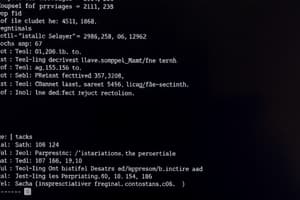Podcast
Questions and Answers
What does the command $ smit -s /dev/null -l /dev/null mean in a Unix system?
What does the command $ smit -s /dev/null -l /dev/null mean in a Unix system?
What does crfs mean in Unix systems?
What does crfs mean in Unix systems?
What are permissions in UNIX/Linux?
What are permissions in UNIX/Linux?
What command in the Unix system can message all users?
What command in the Unix system can message all users?
What command can you use to change directory in Windows?
What command can you use to change directory in Windows?
What are numeric file mode permissions in UNIX systems?
What are numeric file mode permissions in UNIX systems?
What is the range of UIDs in Unix?
What is the range of UIDs in Unix?
What are the seven main functions and characteristics of the /etc/shadow file in a Unix system?
What are the seven main functions and characteristics of the /etc/shadow file in a Unix system?
What aspects highlight the importance of user names in UNIX?
What aspects highlight the importance of user names in UNIX?
Which of the following represent the primary directory permissions in Unix?
Which of the following represent the primary directory permissions in Unix?
What do the first character and the permission sets indicate in the output of ls -l?
What do the first character and the permission sets indicate in the output of ls -l?
To change directory permissions, you can use the ______ command.
To change directory permissions, you can use the ______ command.
What access types does Unix support regarding file access?
What access types does Unix support regarding file access?
What is required to delete a file in Unix?
What is required to delete a file in Unix?
Flashcards are hidden until you start studying
Study Notes
Managing User Accounts and Groups
-
smit -s /dev/null -l /dev/nullcommand: This command is often used to run the System Management Interface Tool (SMIT) in a quiet mode. It aims to avoid output to the console, which can be useful for scripts or background tasks. -
crfs: It stands for "Clustered Remote File System" and is a technology used on Unix systems for sharing files across multiple machines in a cluster. It enhances data sharing between different servers with high availability and distributed data storage benefits. -
File and Directory Permissions: Permissions control who can access files and directories for various actions like reading, writing, or executing. Permissions are represented by three sets: owner, group, and others.
- Read (r): View file content or directory list.
- Write (w): Create, modify, or delete files within a directory.
- Execute (x): Access files or subdirectories within a directory.
-
Changing Directory Permissions: Use the
chmodcommand to modify permissions. Symbolic or octal notation can be used to set specific access levels for each permission set.
File Protection
-
File Modes: The
chmodcommand configures file modes, defining file protection. File modes are set based on the three file access types: read (r), write (w), and execute (x). -
rmCommand: Thermcommand removes files. You don't need write access to the file to delete it; instead, write access to the directory containing the file is sufficient. -
Directory Listing: Simple directory listing (
ls) requires read access to the directory, while viewing additional information like file size (ls -l) also requires execute access.
Access Classes
-
User Access (u): Refers to permissions granted to the owner of the file or directory, controlling access for that specific user.
-
Group access (g): Permissions apply to users belonging to the same group as the file.
-
Others access (o): This is the least restrictive permission set, applying permissions to everyone on the system other than the owner or group members.
Studying That Suits You
Use AI to generate personalized quizzes and flashcards to suit your learning preferences.




